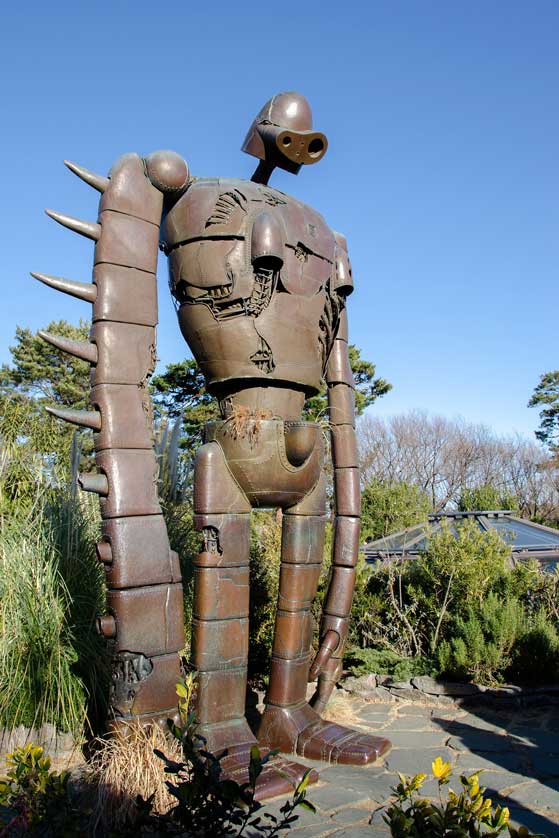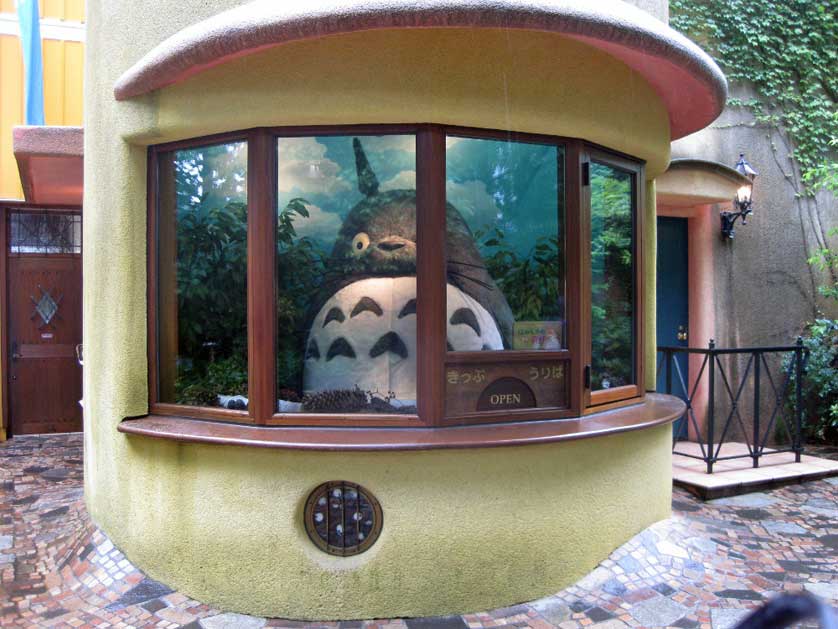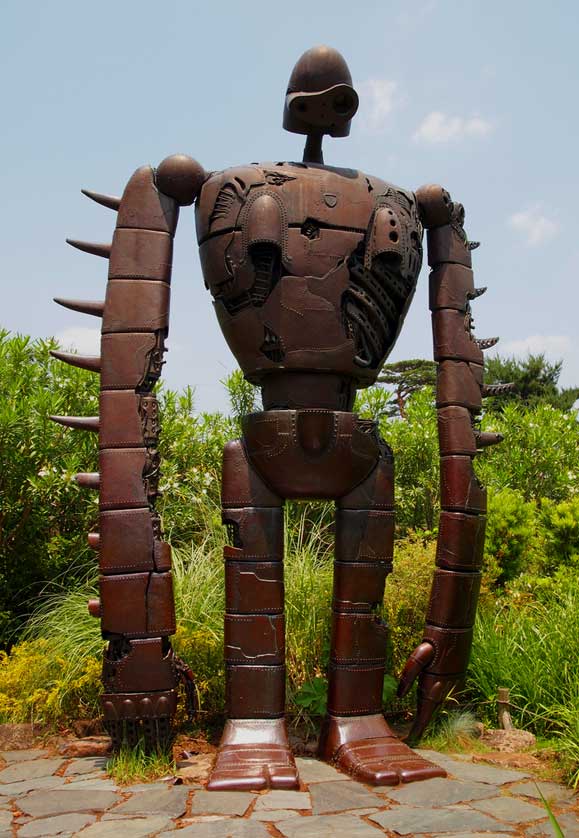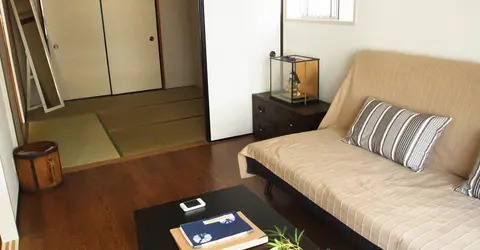Ghibli Museum Mitaka Tokyo: A magical journey into the world of Studio Ghibli
- Published on : 24/07/2024
- by : Japan Experience
- Youtube

Robot Soldier on the Ghibli Museum Rooftop, Mitaka, Tokyo
Nestled in the heart of Mitaka, Tokyo, lies a whimsical haven that transports visitors into the enchanting world of Studio Ghibli. The Ghibli Museum stands as a testament to the artistry, imagination, and timeless storytelling that have captivated audiences worldwide. Featuring beloved characters from iconic films like "My Neighbor Totoro", "Spirited Away", and "Princess Mononoke", this museum celebrates the visionary brilliance of Miyazaki Hayaoand the creative genius behind Studio Ghibli's mesmerizing animations. As you step into this magical realm, prepare to be transported into a world where imagination knows no bounds and every corner holds a new wonder to discover.
Overview and history of the Ghibli Museum
The Ghibli Museum traces its origins to the visionary spirit of Miyazaki Hayao. Along with fellow animator Isao Takahata and producer Toshio Suzuki, they established Studio Ghibli in 1985 with the ambition of creating animated films that transcended age and cultural barriers. As Studio Ghibli garnered acclaim for timeless works like "Spirited Away" and "Ponyo", Miyazaki envisioned a haven where fans could fully immerse themselves in the enchanting realms he had brought to life.
The planning for the museum began in 1998, with construction starting in March 2000. Upon its completion, the museum officially opened its doors on October 1, 2001, quickly winning the hearts of visitors worldwide. From the rooftop garden, where the towering robot from "Castle in the Sky" overlooks the Tokyo skyline, to the whimsical Cat Bus room inspired by My Neighbor Totoro, every nook and cranny of the museum beckons visitors to enter the magical world of Studio Ghibli and uncover the secrets behind the studio's masterpieces.
Planning your visit: Tickets, access, and best times to go
Visiting the Ghibli Museum requires careful planning, as it's one of Tokyo's most popular attractions. Tickets must be purchased in advance, and they often sell out quickly. Here's what you need to know:
- Ticket prices: Adults (19 and over) - ¥1,000, Ages 13-18 - ¥700, Ages 7-12 - ¥400, Ages 4-6 - ¥100, Children 3 and under - free
- Purchasing tickets: Tickets can be bought through the Studio Ghibli website, Lawson convenience stores in Japan, or through travel agencies abroad
- Best times to visit: Weekdays tend to be less crowded, especially during non-holiday periods
Access to the museum is relatively straightforward:
- From Shinjuku Station, take the JR Chuo Line to Mitaka Station (20 minutes)
- From the south exit of Mitaka Station, it's a 15-minute walk or a short bus ride to the museum
- Alternatively, you can access the museum from Kichijoji Station on the Keio Inokashira Line
To make the most of your visit, arrive early and allow at least 2-3 hours to explore the museum thoroughly.

Entrance to Ghibli Museum, Mitaka, Tokyo
Exploring the museum's unique architecture and design
Miyazaki Hayao himself designed the Ghibli Museum, using storyboards similar to those he creates for his films. The result is a whimsical and intricate building that seems to have sprung directly from one of his animated worlds. Key architectural features include:
- Exterior walls covered in colorful foliage, blending seamlessly with the surrounding Inokashira Park
- Spiral staircases and bridges that create a maze-like interior, encouraging exploration
- Stained glass windows featuring Ghibli characters and nature motifs
- A central hall with a glass dome, allowing natural light to flood the space
The museum's design philosophy embraces the concept of "Let's get lost together", inviting visitors to wander and discover hidden treasures throughout the building. This approach reflects Miyazaki's vision of creating a space that sparks imagination and wonder in visitors of all ages.
Must-see permanent exhibitions and interactive displays
The Ghibli Museum offers a variety of permanent exhibitions that provide insight into the world of animation and the creative process behind Studio Ghibli's films. Some highlights include:
- Where a Film is Born: A recreation of an animation studio, complete with artists' desks and storyboards
- The Room of Movement: An exhibit showcasing the history and science of animation, including a 3D zoetrope featuring Ghibli characters
- Cat Bus Room: A life-sized replica of the iconic Cat Bus from My Neighbor Totoro, where children can play
- Tri Hawks Reading Room: A cozy library filled with books that have inspired Miyazaki and other Ghibli creators
These exhibitions offer visitors a unique opportunity to explore the creative process behind Studio Ghibli's animated masterpieces and gain a deeper appreciation for the artistry involved in bringing these magical worlds to life.

Meeting Totoro at Ghibli Museum, Mitaka, Tokyo
Exclusive short films at the Saturn Theater
One of the most anticipated experiences at the Ghibli Museum is the chance to view exclusive short films created specifically for the museum. The Saturn Theater, located in the basement, screens these original Ghibli animations that can't be seen anywhere else. Some of the short films you might encounter include:
- "Mei and the Kittenbus" - a mini-sequel to My Neighbor Totoro
- "Water Spider Monmon" - a delightful tale about a water spider's adventures
- "The Day I Harvested a Star" - a whimsical story set in a fantastical world
- "Boro the Caterpillar" - Miyazaki's first CGI short film
These short films, typically running about 15 minutes, offer a rare glimpse into new Ghibli stories and showcase the studio's continued innovation in animation techniques. The theater's unique design, with windows that open to reveal natural light after the screening, adds to the magical atmosphere of the experience.
Special exhibitions and rotating displays
In addition to its permanent exhibits, the Ghibli Museum hosts special exhibitions that change periodically, offering visitors fresh insights into the world of Studio Ghibli. These exhibitions often focus on specific themes, films, or aspects of the animation process. Some notable past exhibitions have included:
- "The Nutcracker and the Mouse King - A Fairy Tale Treasure"
- "Painting the Colors of Our Films" - exploring the color palettes used in Ghibli animations
- "The View from the Cat Bus" - offering unique perspectives on Ghibli worlds
These rotating displays ensure that even repeat visitors to the museum can discover something new and exciting with each visit. The special exhibitions often delve deeper into the artistic process, showcasing original sketches, storyboards, and concept art that provide valuable insights into the creation of Ghibli's beloved films.
Beyond the exhibits: Rooftop garden, Catbus room, and other attractions
The Ghibli Museum offers more than just traditional exhibits. Visitors can explore several unique spaces that bring the magic of Studio Ghibli to life:
- Rooftop Garden: Home to a life-sized statue of the Robot Soldier from "Castle in the Sky", offering panoramic views of Inokashira Park
- Catbus Room: A playroom featuring a large, plush version of the Cat Bus from My Neighbor Totoro, designed for children to climb and play in
- Straw Hat Café: A charming eatery serving Ghibli-inspired dishes and drinks
- Mamma Aiuto Gift Shop: Named after the sky pirates in "Porco Rosso", offering exclusive Ghibli merchandise

Robot Soldier on the Ghibli Museum Rooftop, Mitaka, Tokyo
These additional attractions provide visitors with opportunities to fully immerse themselves in the Ghibli experience, from relaxing in the peaceful rooftop garden to enjoying a themed meal or bringing home a unique souvenir.
As you conclude your journey through the Ghibli Museum, you'll find that it's more than just a collection of exhibits – it's a portal into the imaginative world of Studio Ghibli. Whether you're a longtime fan or new to the studio's work, the museum offers a magical experience that celebrates the art of animation and the power of storytelling. From the meticulously designed architecture to the exclusive short films and interactive displays, every aspect of the museum invites visitors to explore, wonder, and dream. As you leave, you'll carry with you not just memories, but a renewed appreciation for the creativity and artistry that make Studio Ghibli's films truly timeless.




























